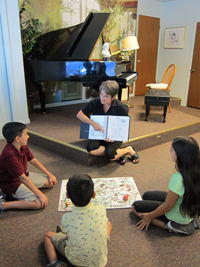28 Aug 2018 -
Mayron Cole interviewed me for her newsletter on techniques used for theory games in piano class…

The beginning of the school year is a vital time to spark students’ interest in piano, so starting the school year by teaching interactive classes that the students find exciting will keep them interested in piano during the upcoming months. Teaching with theory games is one way to keep students engaged in learning.
We interviewed Tanya Ulsh, owner of Tanya’s Piano Studio located in New Braunfels, TX, to discuss how she uses games to teach and reinforce theory concepts.
MUSE: Tanya, you have been teaching group piano for many years now. How do you make learning theory more enjoyable for your students.
TANYA: I incorporate theory time into the last ten minutes of each piano class. The piano class students really enjoy having fun as a class and answering theory questions. I tell students during piano class to listen closely to everything I am telling them because that information will be used at theory game time as questions. I also tell the piano class that any new information included in that lesson’s theory pages will definitely be asked at game time. This really keeps the students interested in what I am teaching.
MUSE: What theory game mats do your students prefer?
TANYA: I teach The Mayron Cole Piano Method and they carry five game mats plus a few bingo games. We alternate using all of the game mats, but which game mats are favorites? I’d say my students like Mayron’s Lost in The Woods and Under The Sea game mats the best. Those game mats are the most challenging. Oh, and FORTE Bingo; Level 2 and 3 students love that game and they sure know their lower bass clef notes after playing FORTE! In the past, I have purchased many expensive computer theory games, but I found that the students quickly became bored with those games. Students come to piano class to interact with their friends, not sit alone at a computer. Plus the computer games took too much time to set up.
MUSE: Give us examples of how you create questions for theory game time.
TANYA: I know before going to game time of each student’s particular learning needs, like needing to review counting rhythm or bass clef staff notes. I can ask each student questions about the topics that student needs more work on. I create the oral questions from previously learned material and that day’s lesson material. I don’t have to write down questions; I just think of the questions as needed. It’s very spontaneous. Any music information that has been covered up through that lesson is fair game for theory game questions.
MUSE: Do you use theory games for just beginners or do you also teach advanced classes using games?
TANYA: I use theory games with students of all ages and levels. My questions can be on the basics of music for beginners, or more advanced theory like key signatures and chord inversions for the higher level students. My advanced teenagers still love to play the games!
MUSE: Do you get feed-back from your students about theory game time?
TANYA: Yes! If we are practicing for an upcoming recital and have no class time for theory games, the students complain. They love playing theory games, and I love how strong my students are with theory concepts as a result of playing the games.
Thanks to Tanya of Tanya’s Piano Studio for taking the time to explain how she engages her students with interactive theory games. As you are starting this new school year, consider incorporating theory games as part of your piano classes.
